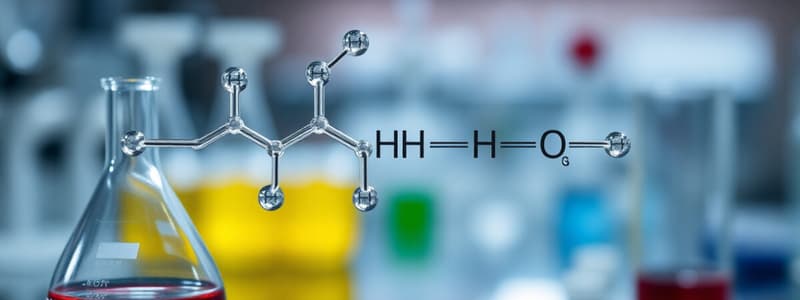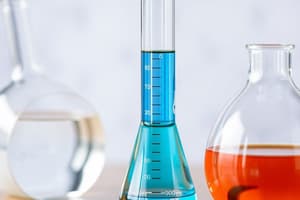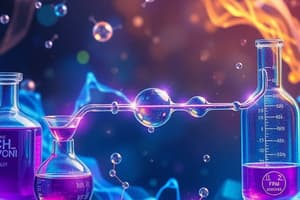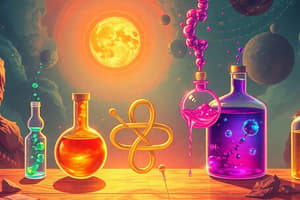Podcast
Questions and Answers
What is the primary function of stoichiometry in chemical reactions?
What is the primary function of stoichiometry in chemical reactions?
- To measure the energy changes during reactions
- To determine the color of reactants involved
- To identify unknown substances in a mixture
- To calculate the quantities of reactants and products (correct)
In the combustion of octane, what is the stoichiometric ratio of moles of C8H18 to moles of CO2 produced?
In the combustion of octane, what is the stoichiometric ratio of moles of C8H18 to moles of CO2 produced?
- 16:2
- 25:16
- 2:16 (correct)
- 2:18
What defines a concentrated solution compared to a dilute solution?
What defines a concentrated solution compared to a dilute solution?
- Faster reaction rate of solutes
- Presence of more solvent than solute
- Higher temperature of the solution
- Larger proportion of solute to solvent (correct)
How are the coefficients in a balanced chemical equation significant to stoichiometry?
How are the coefficients in a balanced chemical equation significant to stoichiometry?
When given 22 moles of C8H18, how many moles of CO2 can be predicted to be produced using stoichiometry?
When given 22 moles of C8H18, how many moles of CO2 can be predicted to be produced using stoichiometry?
What is the correct formula to calculate molarity (M) of a solution?
What is the correct formula to calculate molarity (M) of a solution?
Which of the following correctly describes the unit of molarity?
Which of the following correctly describes the unit of molarity?
In the context of molarity, if 25.5 g of KBr is dissolved in 1.75 L of solution, what is the first step needed to find the molarity?
In the context of molarity, if 25.5 g of KBr is dissolved in 1.75 L of solution, what is the first step needed to find the molarity?
If a solution has a molarity of 0.125 M and contains 0.255 mol of NaOH, how would you calculate the volume of the solution?
If a solution has a molarity of 0.125 M and contains 0.255 mol of NaOH, how would you calculate the volume of the solution?
Which concentration unit uses grams of solute per 1000 grams of solvent?
Which concentration unit uses grams of solute per 1000 grams of solvent?
Which of the following substances is classified as a strong electrolyte?
Which of the following substances is classified as a strong electrolyte?
What distinguishes weak electrolytes from nonelectrolytes?
What distinguishes weak electrolytes from nonelectrolytes?
Which of the following compounds is a weak acid?
Which of the following compounds is a weak acid?
In which type of reaction do two or more reactants combine to form a single product?
In which type of reaction do two or more reactants combine to form a single product?
Which of the following statements about nonelectrolytes is true?
Which of the following statements about nonelectrolytes is true?
What type of reaction is demonstrated by the equation 2 H2O ⟶ 2 H2 + O2?
What type of reaction is demonstrated by the equation 2 H2O ⟶ 2 H2 + O2?
In a double replacement reaction, what is expected to occur?
In a double replacement reaction, what is expected to occur?
What happens during a single replacement reaction?
What happens during a single replacement reaction?
Which equation represents a synthesis reaction?
Which equation represents a synthesis reaction?
What would result from mixing a metallic hydroxide with an acid according to the information provided?
What would result from mixing a metallic hydroxide with an acid according to the information provided?
Flashcards
Stoichiometry
Stoichiometry
Calculations of the amounts of reactants and products in a chemical reaction.
Conversion Factor (Stoichiometry)
Conversion Factor (Stoichiometry)
The ratio of moles of one substance to moles of another substance in a balanced chemical equation.
Solution
Solution
A homogenous mixture of two or more substances.
Solvent
Solvent
Signup and view all the flashcards
Solute
Solute
Signup and view all the flashcards
Synthesis Reaction
Synthesis Reaction
Signup and view all the flashcards
Electrolyte Solution
Electrolyte Solution
Signup and view all the flashcards
Strong Electrolyte
Strong Electrolyte
Signup and view all the flashcards
Weak Electrolyte
Weak Electrolyte
Signup and view all the flashcards
Nonelectrolyte
Nonelectrolyte
Signup and view all the flashcards
Molarity
Molarity
Signup and view all the flashcards
Molarity Units
Molarity Units
Signup and view all the flashcards
Molarity Calculation
Molarity Calculation
Signup and view all the flashcards
Concentration Units (ppm/ppb)
Concentration Units (ppm/ppb)
Signup and view all the flashcards
Decomposition Reaction
Decomposition Reaction
Signup and view all the flashcards
Example of a decomposition reaction
Example of a decomposition reaction
Signup and view all the flashcards
Single Replacement Reaction
Single Replacement Reaction
Signup and view all the flashcards
Double Replacement Reaction
Double Replacement Reaction
Signup and view all the flashcards
Formation of Water
Formation of Water
Signup and view all the flashcards
Study Notes
General Chemistry for Pharmaceutical Sciences (PHARM-101)
- Course presented by Dr. Azza H. Rageh, Associate Professor of Pharmaceutical Analytical Chemistry at Taibah University
- Course covers Stoichiometry, Solution Concentration, and Chemical Reactions.
Stoichiometry
- Stoichiometry involves calculating the amounts of reactants and products in a chemical reaction
- It allows predicting product amounts based on reactant amounts
- It determines the necessary reactants to create a specific amount of product.
- Coefficients in balanced chemical equations represent relative mole amounts of substances.
Reaction Stoichiometry
- Example: 2 C8H18(l) + 25 O2(g) → 16 CO2(g) + 18 H2O(g)
- 2 moles of C8H18 react with 25 moles of O2 to form 16 moles of CO2 and 18 moles of H2O.
- This example demonstrates the stoichiometric ratio between reactants and products. Stoichiometric ratios are used to calculate product amounts (or needed quantities of reactants).
Concentration of Solutions
- Concentration measures the amount of solute in a solution
- Units for concentration include percentage by weight, percentage by volume, parts per million, parts per billion, molarity, formality, normality and molality.
- Molarity (M) is a measure of concentration.
- Molarity (M) = moles of solute / liters of solution
Molarity Calculations
-
Example 1: Find the molarity of a solution with 25.5 g KBr dissolved in 1.75 L of solution.
- Molarity (M) = 0.122 M
-
Example 2: Calculate the liters of 0.125 M NaOH solution containing 0.255 mol NaOH.
- Liters (L) = 2.04 L
Types of Aqueous Solutions and Solubility
- Familiar examples include salt water (NaCl & H2O) and sugar water (C12H22O11 & H2O).
- These solutions are homogeneous mixtures.
- Solids like salt and sugar dissolve in water because of attractive forces between solute and solvent particles.
Dissolving of Ionic Compounds
- Each ion in the compound is attracted to surrounding water molecules.
- The water molecules pull the ions away from the crystal
Dissolving of Molecular Compounds
- Molecules of the compound mix homogeneously with water molecules.
Electrolytes and Nonelectrolytes
- Electrolytes dissolve in water to form solutions that conduct electricity (ions formed).
- Nonelectrolytes do not form ions when dissolved in water.
- Strong Electrolytes: completely ionize
- Weak Electrolytes: partially ionize
Types of Chemical Reactions (A Summary)
- Synthesis, Decomposition, Single Replacement, Double Replacement
Basic Types of Chemical Reactions
- Synthesis: Two or more reactants combine to form one product. (A + B → AB)
- Decomposition: A complex substance breaks down into simpler substances. (AB → A + B)
- Replacement (Single): One element replaces another in a compound. (A + BC → AC + B)
- Replacement (Double): The cations and anions of two ionic compounds switch places. (AB + CD → AD + CB)
Chemical Reactions Between Ions
- Ions react through water formation, weak electrolytes, precipitates, gases, and complex ion formation
Formation of Water: Acid-Base Reactions
- Metal hydroxides (including ammonium hydroxide) react with acids to form water.
- Example: NaOH + HCl → NaCl + H2O
Formation of Weak Electrolytes
- A strong acid with a salt that contains the anion of a weak acid forms the weak acid.
- Example: HCl + CH3COONa → NaCl + CH3COOH (weak acid)
Formation of a Precipitate
- Precipitation occurs when the concentration of dissolved ions exceeds the solubility limit forming an insoluble salt in a solution. Precipitate is solid.
- Example: AgNO3 + NaCl → AgCl(s) + NaNO3
Formation of Gas
- Formation of a gas results from the product being gaseous or the product decomposing to form gas.
- Example: 2H+ + S2- → H2S(g) -Example: Acid forms unstable acids (H2CO3, H2SO3, H2S2O3, HNO2)
Formation of Complex Ions
- A complexation reaction involves a Lewis acid (metal) and a Lewis base (ligand).
- Ligands form coordinate bonds to the metal to form a complex.
- Example: Cu2+ + 4 NH3 → [Cu(NH3)4]2+
Reactions Involving Oxidation-Reduction (Redox)
- Redox reactions involve electron transfer.
- Oxidation is a loss of electrons, reduction is a gain of electrons.
- Oxidation and reduction reactions must always occur together.
- Example: 2 Na(s) + Cl2(g) → 2 NaCl(s)
Oxidizing and Reducing Agents
- Oxidizing agent (oxidant) causes oxidation, and is reduced itself.
- Reducing agent (reductant) causes reduction and is oxidized itself.
- Example: 2C8H18(l) + 25 O2(g) → 16CO2(g) + 18 H2O(g)
Assessment Questions
- Various assessment questions are provided related to the topics covered, including identifying products of reactions, classifying reaction types, calculating oxidation numbers, identifying oxidizing and reducing agents, and defining chemical reactions.
Studying That Suits You
Use AI to generate personalized quizzes and flashcards to suit your learning preferences.
Related Documents
Description
Test your knowledge of stoichiometry as it applies to chemical reactions in the context of pharmaceutical sciences. This quiz covers the calculation of reactants and products, as well as the interpretation of balanced chemical equations. Prepare to apply your understanding of chemical relationships in practical scenarios.




